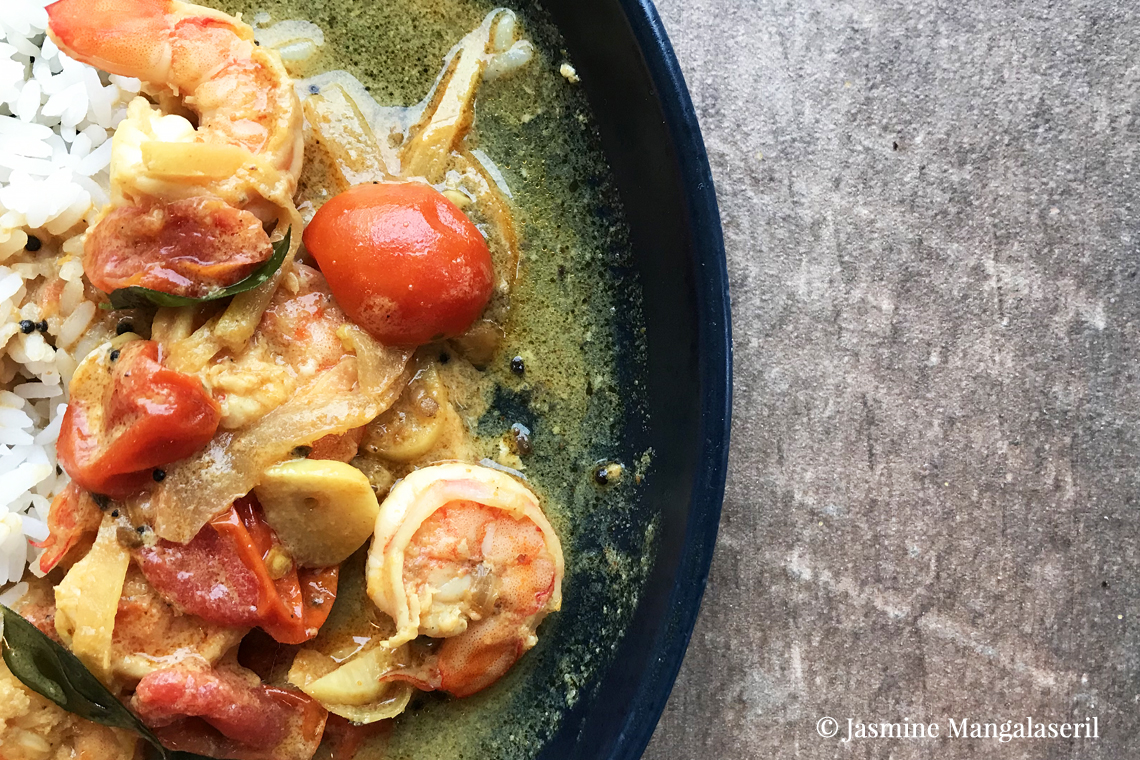Shrimp Pappas — also called Shrimp Mappas — is a dish that combines Kerala’s classic flavours associated with seafood dishes: creamy sweetness of coconut, citrussy and musky spices, a bit of chilli heat, and the signature sourness that comes from kudampuli.
This recipe was featured in my A World In My Kitchen series for the Waterloo Public Library.
(Scroll past the video for the recipe)
Shrimp Pappas – Kerala-style shrimp in coconut milk
Ingredients
- 3 pieces kudampuli (see ingredients notes)
- Water, from a recently boiled kettle, as needed
- 45 ml flavourless oil or cooking oil (3 Tbsp)
- 5 ml brown mustard seeds (1 tsp)
- 2.5 ml fennel seeds (½ tsp)
- 1.25 ml fenugreek seeds (¼ tsp)
- 2 sprigs curry leaves (approx 24 leaves), divided (see ingredients notes)
- 100 g sliced onions (1 cup)
- 15 g ginger, sliced into matchsticks (5 cm piece)
- 6 garlic cloves, thinly sliced
- 2 long green chillies, slit, to taste (see ingredients notes)
- 400 ml thin coconut milk (approx 1½ cups + 2 Tbsp) (see ingredients notes)
- 500 g deveined and shelled shrimp (fresh or thawed)
- 150 g halved cherry tomatoes (1 cup), optional, to taste
- 5 ml salt, to taste (1 tsp)
- 100 ml thick coconut milk (⅓ cup + 1 Tbsp) (see ingredients notes)
Masala
- 10 ml coriander powder (2 tsp)
- 5 ml Kashmiri chilli powder (1 tsp), to taste (see ingredients notes)
- 2.5 ml turmeric powder
- 2.5 ml black pepper
Instructions
- Steep the kudampuli in enough hot water to cover. In a separate bowl, mix the masala (coriander, Kashmiri chilli, turmeric, and black pepper) and set aside.
- Heat oil over a medium flame until it shimmers before adding the mustard and fennel seeds. When the mustard begins to splutter, add the fenugreek. Fry until they darken—this will only take a few seconds. Then, add half the curry leaves. When they frizzle and darken add the onion and cook until they soften and turn colour. Then, add the ginger, garlic, and slit chillies.
- Add the masala and fry until the spices exude their oils and release their scent.
- Add the kudampuli water and thin coconut milk. Bring the mixture to a boil. Lower the flame to medium-low and let the mixture die down to a simmer and stir for about 8 minutes as it thickens.
- Add the shrimp, tomatoes, and salt. Stir for about 5 minutes, or until the shrimp is opaque and just cooked. Stir in the thick coconut milk and the remaining curry leaves. Remove from heat when it comes to a boil. If the tomates are still firm, lid the pan and let them steam until soft. Taste for salt and serve.
Notes
To serve:
- Plain steamed rice OR chapati OR appam
Ingredients and substitution notes:
Coconut milk (thin and thick) – The thickness of milk refers to which pressing/extraction, with the thicker extractions being the earlier ones. Here’s how I make my own, from tinned coconut milk.- Thick: all tinned coconut milk
- Medium-thick: 2 parts coconut milk : 1 part water
- Thin: 1 part coconut milk : 1 part water
- In this recipe, you can substitute as much (or little) of your chilli pepper powder of choice, making up the difference in volume with sweet paprika with a few pinches of smoked paprika (hot or sweet).
- In this recipe, you can substitute about a cup of chopped tomatoes with a quarter teaspoon of smoked sweet paprika. It won’t taste the same, but it will provide some of the acidity. If you use chopped tomatoes instead of kudampuli, don’t add the cherry tomatoes.

